Council on Tall Buildings Rewards Sustainability in 2008 Skyscrapers
Amid a breaking wave of international development, sustainability keeps high rises relevant
by Zach Mortice
Associate Editor
Summary: This year’s Council on Tall Buildings and Urban Habitat Best Tall Building Awards focused on sustainable projects. It selected KPF’s Shanghai World Financial Center as the best tall building in 2008 and honored William Baker of SOM with the Fazlur Rahman Khan Medal and Cesar Pelli with the Lynne S. Beedle Lifetime Achievement Award.
Though it witnessed the boom and bust of an incredible phase of development, 2008 won’t likely be remembered as the year of the skyscraper. Its architectural icons were more often formally daring public buildings, like Herzog and De Meuron’s Bird’s Nest Stadium, or emphatically “anti-skyscrapers,” like Rem Koolhaas’ vertical loop CCTV Headquarters, both in Beijing. The development boom that fueled this year’s Council on Tall Buildings and Urban Habitat Best Tall Building Awards (announced November 20) hasn’t quite crested, as the 160-plus-story Burj Dubai nears completion, and construction has began for Gensler’s Shanghai Tower, which it to become the tallest building in China.
But many skyscraper projects have proven too easy to topple in today’s global economic meltdown. (Recent casualties: Santiago Calatrava’s Chicago Spire, Jean Nouvel’s condo towers in Los Angeles and New York City—all frozen without funding.) Skyscrapers no longer can embrace their most fundamental elements of tallness and size as an economic saving grace: today, sustainability drives the design and construction (and funding) of the global elite high-rise development. This year, each of the council’s selections found new ways to make this quintessential 20th-century building type more environmentally collaborative, efficient, and, most importantly, relevant—like a typology that will be worthy of awards far into the 21st-century.
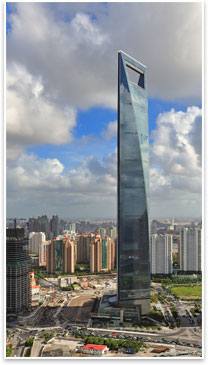 Best Tall Building Best Tall Building
Project: Shanghai World Financial Center
Architect: KPF
Location: Shanghai
Height: 101 stories, 1,620 feet
The Asia and Australia regional and overall winner, The Shanghai World Financial Center takes a few simple geometric elements (a prism, two curving arcs, a trapezoid) that are tied to cultural signifiers and creates a stately and composed mixed-use tower. From a square base, it rises up as two arcs across opposite façades thin and narrow its profile. It meets the clouds with an open cavity “sky portal” (as KPF calls it) that widens as it rises and contains some of the world’s highest observation spaces accessible to the public. The World Financial Center also earned high marks for its innovative structural system, which the jury called “nothing short of genius.” Skyscraper engineering stalwarts LERA found a way to increase the building’s volume by 20 percent without increasing its weight and need for more materials, making a lighter, more efficient tall building, according to Architectural Record. “It speaks to where tall building design is today,” said the jury.
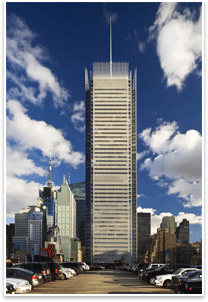 Best Tall Building in the Americas Best Tall Building in the Americas
Project: The New York Times Building
Architect: Renzo Piano Building Workshop
Location: New York City
Height: 52 stories, 746 feet
AIA Gold Medal Winner Renzo Piano’s first skyscraper project “is the 21rst century Seagram Building,” according to the jury. It takes the clean, honest structural expression of classic glass and steel Modernist skyscrapers and combines it with contemporary formal sustainability features: In this case, a dual skin of glass covered in ceramic rods that diffuse the buildings sharp edges and provide solar shading. An AIA Honor Award Winner, the building also employs a mechanized window shading system that uses the sun’s position in the sky to maximize natural light and minimize unnecessary solar heat gain. An on-site gas cogeneration plant creates 40 percent of the building’s energy and sends excess heat off to warm the building. The tower’s use of glass also creates allusions to the contemporary media’s responsibility to be an open and transparent arbiter of information. By providing view corridors through the building’s auditorium, wooded atrium, and lobby, Piano’s tower welcomes the community in and assembles an inspiring and engaging panoply for the journalists who work there to document. “The articulation of the façade is beautiful,” said the jury. “This building takes the box to the next level.”
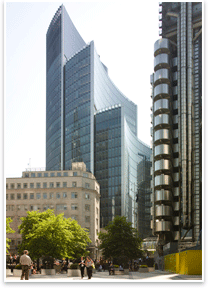 Best Tall Building in Europe Best Tall Building in Europe
Project: 51 Lime Street, The Willis Building
Architect: Foster and Partners
Location: London
Height: 29 stories, 410 feet
Fifty-one Lime Street was conceived as a series of three interlocking shells that would curve around and step down to a public plaza. Foster’s building is separated into three distinct masses, with rooftop terraces at the 16th and 23rd floors. This relatively short skyscraper gains additional vertical momentum from its straight saw-toothed vertical louvers. Like the Times Building, this innovative façade provides energy savings through solar shading. The north and south façades of the Willis Building are covered in sawtooth envelope fins that are glazed on one side and solid on the other to reduce heat gain. The east and west façades are double-skinned and glazed with a ventilated cavity in between, according to Building. “A project that integrates well with the urban context, both historic and modern,” said the jury. “I appreciate its sensitivity to the environment through the building’s serrated exterior that simultaneously shades from the sun and lets views out.”
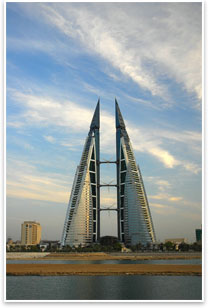 Best Tall Building in the Middle East and Africa Best Tall Building in the Middle East and Africa
Project: Bahrain World Trade Center
Architect: Atkins Design Studio
Location: Manama, Bahrain
Height: 50 stories, 787 feet
The Bahrain World Trade Center’s twin conical, 50-story towers resemble a sail and perform as a sail, too. Both rounded and sculpted towers face north toward the Persian Gulf. Their shape funnels and accelerates wind into three massive wind turbines that are connected to sky bridges between the buildings. These turbines are the first large-scale wind turbines to generate energy (11 to 15 percent of the building’s total requirements, according to Reuters) in a commercial building. The tapering of each tower from bottom to top reduces wind resistance from higher velocity winds at higher elevations, thus keeping all three turbines spinning at more consistent speeds. “The Bahrain World Trade Center project is iconic, environmental, and a bit quirky ... it gives a very strong visual nod toward sustainability,” said the jury.
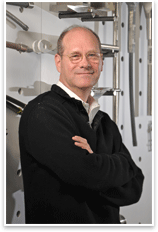 Fazlur Rahman Khan Medal Fazlur Rahman Khan Medal
William Baker of SOM
The Fazlur Rahman Khan Medal for Lifetime Achievement recognizes an individual for demonstrated excellence in design and research that has made important contributions to the construction of tall buildings. As Kahn’s successor at SOM, structural engineer William Baker’s victory has created a sort of homecoming for the award. Baker (who works in SOM’s London and Chicago offices) built on the skyscraper research that Khan initiated to create what will likely be the tallest building in the world, the Burj Dubai. His refinements to Khan’s ideas about constructing skyscrapers as singular, structural tubes have pushed tall building design into the 21rst century. Baker’s other major projects include the Infinity Tower in Dubai, the Trump Tower International Hotel in Chicago, and the Virginia Beach Convention Center.
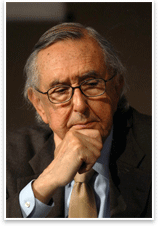 Lynne S. Beedle Lifetime Achievement Award Lynne S. Beedle Lifetime Achievement Award
Cesar Pelli, FAIA
The Lynne S. Beedle Lifetime Achievement Award recognizes an individual who has made significant contributions to the advancement of tall buildings and the urban environment. Appropriately, then, Cesar Pelli’s work was once the pinnacle of tall building design. His pagoda-shaped Petronas Towers in Kuala Lumpur were the world’s tallest buildings from 1998 to 2004. Before and after the Towers, Pelli and his New Haven, Conn.-based firm Pelli Clarke Pelli have forged a middle path between Miesian Modernism and historicist Postmodernism, with curving glass facades and thoughtful reimaginings of Classical and Art Deco detailing. A prolific skyscraper designer, Pelli’s major projects include the Bank of America Corporate Center in Charlotte, the World Financial Center in New York City, the Wells Fargo Center in Minneapolis, and the Transbay Transit Center in San Francisco.
|


 Best Tall Building
Best Tall Building Best Tall Building in the Americas
Best Tall Building in the Americas Best Tall Building in Europe
Best Tall Building in Europe Best Tall Building in the Middle East and Africa
Best Tall Building in the Middle East and Africa Fazlur Rahman Khan Medal
Fazlur Rahman Khan Medal Lynne S. Beedle Lifetime Achievement Award
Lynne S. Beedle Lifetime Achievement Award